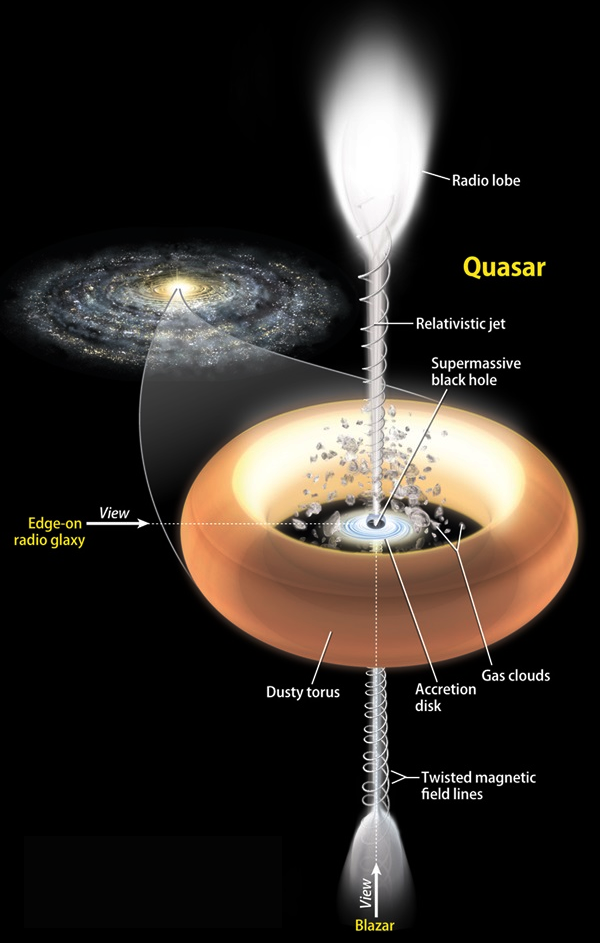Science & Technology
Most Distant Quasar P172+18
- 09 Mar 2021
- 5 min read
Why in News
Recently, an international team of astronomers has discovered the most distant ‘Radio-Loud’ Quasar with the help of European Southern Observatory’s Very Large Telescope (ESO’s VLT).
Key Points
- Quasars:
- Quasars are very luminous objects in faraway galaxies that emit jets at radio frequencies.
- The word quasar is short for "quasi-stellar radio source".
- The name, which means star-like emitters of radio waves, was given in the 1960s when quasars were first detected.
- The name is retained today, even though astronomers now know most quasars are faint radio emitters. In addition to radio waves and visible light, quasars also emit ultraviolet rays, infrared waves, X-rays, and gamma-rays.
- Most quasars are larger than our solar system. A quasar is approximately 1 kiloparsec in width.
- They are only found in galaxies that have supermassive blackholes which power these bright discs.
- Most active galaxies have a supermassive black hole at the centre which sucks in surrounding objects.
- Quasars are formed by the energy emitted by materials swirling around a blackhole right before being sucked into it.
- They are further categorised into the "radio-loud" and the "radio-quiet" classes.
- Radio-loud:
- They are with powerful jets that are strong sources of radio-wavelength emission.
- These make up about 10% of the overall quasar population.
- Radio-quiet :
- They are those quasars lacking powerful jets, with relatively weaker radio emission than the radio-loud population.
- The majority of quasars (about 90%) are radio-quiet.
- Radio-loud:
- Recently Discovered Quasar/P172+18:
- Named P172+18, the quasar emitted wavelengths which had a redshift of 6.8.
- It took 13 billion years for the quasar’s light to reach earth.
- This particular quasar appears to the scientists as it was when the universe was just around 780 million years old.
- The glowing disc around a blackhole is 300 million times more massive than our Sun.
- It is also one of the fastest accreting quasars, which means it is accumulating objects from the galaxy at an enormous speed.
- Only three other ‘radio-loud’ sources with redshift greater than six have been discovered so far and the most distant one had a redshift of 6.18.
- The higher the redshift of the radio wavelength, the farther away is the source.
- Named P172+18, the quasar emitted wavelengths which had a redshift of 6.8.
- Inference:
- The blackhole at its centre is consuming from its galaxy at a stunning rate.
- Significance:
- A detailed study of these ‘radio-loud’ super bright objects can lead astronomers to understanding how the supermassive blackholes in their core grew to be as big so rapidly since the Big Bang.
- It also holds clues about the ancient star systems and astronomical bodies.
- About the ESO’s VLT:
- The Very Large Telescope used to observe the P172+18 is located at Paranal Observatory in the Atacama Desert.
- The four Unit Telescopes boast 8.2-meter (27 feet) mirrors.
- Just one of these instruments can spot objects that are 4 billion times fainter than what can be seen with the unaided eye.
- According to the European Southern Observatory, the Very Large Telescope is the world's most advanced optical telescope.
- The Very Large Telescope used to observe the P172+18 is located at Paranal Observatory in the Atacama Desert.
Redshift
- Gravitational redshift occurs as particles of light (photons) climb out of a gravitational well like a black hole and the light's wavelength gets drawn out. This shifts the wavelength to the red part of the light spectrum - hence "redshift".
- In order to escape intense gravity, particles of light (photons) must expend energy.
- However, at the same time, these photons must travel at a constant speed - the speed of light.
- Therefore, the photons can't lose energy by slowing down but must expend it in another way.
- This lost energy manifests itself as a shift towards the red end of the light spectrum.







